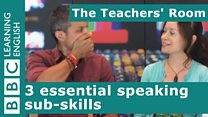Unit 23: English You Need
Exams, news, pronunciation, teachers' tips, learners' questions
Select a unit
- 1 English You Need
- 2 English You Need
- 3 English You Need
- 4 English You Need
- 5 English You Need
- 6 English You Need
- 7 English You Need
- 8 English You Need
- 9 English You Need
- 10 English You Need
- 11 English You Need
- 12 English You Need
- 13 English You Need
- 14 English You Need
- 15 English You Need
- 16 English You Need
- 17 English You Need
- 18 English You Need
- 19 English You Need
- 20 English You Need
- 21 English You Need
- 22 English You Need
- 23 English You Need
- 24 English You Need
- 25 English You Need
- 26 English You Need
- 27 English You Need
- 28 English You Need
- 29 English You Need
- 30 English You Need
Session 4
Welcome to The Teachers’ Room. The show all about teaching practice. Grab a cup of coffee, pull up an armchair and relax. Learn something new, remember something fundamental or just have a giggle.
Activity 1
The Teachers' Room
Bad teaching habits 1
Dan and Sian talk about three bad habits that many teachers may have
Watch the video and complete the activity

___________________________________________________________________
Did you like that? Why not try these?


 ___________________________________________________________________________________
___________________________________________________________________________________
Bad teaching habits 1
No teacher is perfect and all teachers have bad habits. Being a good teacher means reflecting on these and trying to reduce them as much as possible.
Too much TTT
TTT stands for teacher talking time. Obviously, during the course of class, it is necessary for the teacher to explain rules, give advice and talk about instructions, among other things. However, teachers should attempt to limit the amount of time that they spend speaking to the class in order to maximise the opportunity that the students have to speak. A good rule of thumb is aiming for around 30% teacher talk to 70% student talk. This means planning out what you will say, when and how.
Echoing
Echoing is when a teacher unnecessarily repeats a student’s answer. A teacher might do it in order to clarify what a student has said, reassure the student who spoke that they were understood by the teacher, or parrot the answer from the student who spoke to the rest of the class to make sure they understood too. This undermines the original speaker and the chance of natural student-to-student communication since it presents the teacher as the only thing that will allow communication from one student to another. Better to ask the student to repeat their sentence, ask them to speak up, continue the conversation as normal or encourage direct interaction by getting a different student to ask a follow up question
Not admitting mistakes
It’s OK to make mistakes as a teacher! Everyone does. But once one has been realised, not admitting to it or seeking to correct it, for whatever reason, is no good. It means that the students could learn information which is at least, misleading and at worst totally incorrect. Bluffing should be avoided at all costs – if you don’t know, just say so, and reassure the student that you will find out. And make sure you do. Failing that you can always make a joke by saying ‘I was just testing to see if you were paying attention!’
To do
Try our quiz to see if you've picked up our tips.
The Teachers' Room Quiz
4 Questions
Check what you've learned by selecting the correct answer to each question.
Help
Activity
Check what you've learned by selecting the correct answer to each question.
Hint
The students should have just over double the talking time of the teacher.Question 1 of 4
Help
Activity
Check what you've learned by selecting the correct answer to each question.
Hint
Dan and Sian mentioned several reasons, all based on the idea of reassuring and supporting the student who spoke, and the class.Question 2 of 4
Help
Activity
Check what you've learned by selecting the correct answer to each question.
Hint
If the teacher constantly repeats the answer every student provides, the rest of the class are likely to stop listening to anyone but the teacher.Question 3 of 4
Help
Activity
Check what you've learned by selecting the correct answer to each question.
Hint
If a teacher makes a mistake and teaches something which is less than correct, what will the students learn?Question 4 of 4
Excellent! Great job! Bad luck! You scored:
Get involved
Well, those were just a few ideas that we here at BBC Learning English had, but we know that you teachers out there have lots of fantastic ideas too, and we’d like you to share them with us and everybody else.
If you have a great tip or technique for good or bad teaching habits, or anything else, please email us at learningenglish@bbc.co.uk. Your email could be posted here on this page, or may even be mentioned in our show.
We are also looking for video tips to include in the programme. You could be rewarded with a T-shirt for your efforts.
End of Session 4
Next up is Learners' Questions. What will this week's Learner Question be? Whatever it is, Dan's here with the answer! Join us in Session 5 to find out.
Session Vocabulary
Bad teaching habits 1
- Too much TTT
- Echoing
- Not admitting a mistake